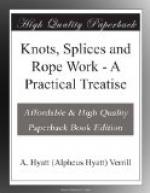[Illustration: FIG. 39.—Timber hitch and half-hitch.]
It is remarkable what power to grip a twisted rope has, and the “Twist Knots” shown in Figs. 40 and 41 illustrate two ways of making fast which are really not knots at all but merely twists. These may be finished by a simple knot, or a bow-knot, as shown in Fig. 42, but they are likely to jam under great pressure and are mainly useful in tying packages, or bundles, with small cord, where the line must be held taut until the knot is completed. This principle of fastening by twisted rope is also utilized in the “Catspaw” (Fig. 43), a most useful knot or “hitch” for hoisting with a hook. To make this, pass the bight of your rope over the end and standing part, then, with a bight in each hand, take three twists from you, then bring the two bights side by side and throw over the hook (Fig. 44).
[Illustration: FIGS. 40 and 41.—“Twists.”]
[Illustration: FIG. 42.—Twist with bow.]
[Illustration: FIG. 43.—Catspaw.]
[Illustration: FIG. 44.—Catspaw (tying).]
The “Blackwall Hitch” (Fig. 45) is still simpler and easier to make and merely consists of a loop, or cuckold’s neck, with the end of rope passed underneath the standing part and across the hook so that as soon as pressure is exerted the standing part bears on the end and jams it against the hook.
[Illustration: FIG. 45.—Blackwall hitch.]
The “Chain Hitch” (Fig. 46) is a very strong method of fastening a line to a timber, or large rope, where one has a rope of sufficient length, and is used frequently to help haul in a large rope or for similar purposes. It consists simply of a number of half-hitches taken at intervals around the object and is sometimes used with a lever or handspike, as shown in Fig. 47. The “Rolling Hitch” is a modified Clove hitch and is shown in Fig. 48. The “Magnus Hitch” (Fig. 49) is a method frequently used on shipboard for holding spars; and the “Studding-sail Bend” (Fig. 50) is also used for this purpose. Occasions sometimes arise where a tackle, hook, ring, or another rope must be fastened to a beam by the same rope being used, and in such cases the “Roband Hitch” (Fig. 51) comes in very handy. These are all so simple and easily understood from the figures that no explanation is necessary. Almost as simple are the “Midshipman’s Hitch” (Fig. 52), the “Fisherman’s Hitch” (Fig. 53), and the “Gaff Topsail Halyard Bend” (Fig. 54). The midshipman’s hitch is made by taking a half-hitch around the standing part and a round turn twice around above it. The fisherman’s hitch is particularly useful in making fast large hawsers; with the end of a rope take two turns around a spar, or through a ring; take a half-hitch around the standing part and under all the turns; then a half-hitch round the standing part only and if desired seize the end to standing part. The gaff-topsail bend is formed by passing two turns around the yard and coming up on a third turn over both the first two turns; over its own part and one turn; then stick the end under the first turn.




